Analysing Hacker News Metadata with R
This page provides a set of examples showing how you can extract various statistics from Hacker News metadata using R: simple statistics such as top domains and top commenters as well as more complex things like charting activity patterns of specific users and activity outlier detection. You can use the thumbnails to scroll down and just take a quick look at the charts or you can go through the whole document and even run the code on your machine for the full experience.
About me and disclaimer You can find more about me on my homepage. I'm interested in data and visualisation. I learned R while creating the examples below so don't take them for granted. If you notice any errors/mistakes or you know how to do the same things better please let me know! Let me know as well if you found this page useful or interesting!
Loading the datasets
If you want to run the the code snippets on this page yourself and perhaps do some experiments of your own you're going to need to clone and extract the datasets from Github. You'll also have to download and install R or R Studio (a lightweight IDE for R).
Once you've got hn_posts.csv and hn_comments.csv on your machine, the first thing you want to do is run the code below to load both datasets into R data frames and parse timestamp strings into POSIXct date-time objects. We also set the global time zone and change it for each timestamp as well. I've chosen EST time zone because presumably the majority of HN users are based in the US and also because EST time is closer to Europen time zones than PST.
Before you run the code below remember to change the paths of the data files to where you have extracted them.
This code block is pretty slow and might take around 5 minutes depending on your machine (there are ways to optimize this. I have not done that, however, in order to keep things simple).
Sys.setenv(TZ="America/New_York") all_posts = read.csv('csv/hn_posts.csv') all_posts$created_at = as.POSIXct(strptime(all_posts$created_at, "%Y-%m-%dT%H:%M:%SZ"), "UTC") attr(all_posts$created_at, 'tzone') = 'America/New_York' all_comments = read.csv('csv/hn_comments.csv') all_comments$created_at = as.POSIXct(strptime(all_comments$created_at, "%Y-%m-%dT%H:%M:%SZ"), "UTC") attr(all_comments$created_at, 'tzone') = 'America/New_York'
If you are new to R it might be useful to know that you can type in ?command into console in order to find out what the command does. For example:
?read.csv
Code below outputs top rows of all_comments and all_posts data frames. Note that rows are sorted by date, that's because they were already sorted in the csv files.
head(all_posts)
## id created_at username domain points ## 1 1 2006-10-09 14:21:51 pg ycombinator.com 39 ## 2 2 2006-10-09 14:30:28 phyllis paulgraham.com 12 ## 3 3 2006-10-09 14:40:33 phyllis foundersatwork.com 7 ## 4 4 2006-10-09 14:47:42 onebeerdave avc.blogs.com 6 ## 5 5 2006-10-09 14:51:04 perler techcrunch.com 6 ## 6 6 2006-10-09 14:56:40 perler 360techblog.com 5
head(all_comments)
## id parent_id created_at username points ## 1 15 1 2006-10-09 15:51:01 sama 3 ## 2 17 15 2006-10-09 15:52:45 pg 4 ## 3 22 21 2006-10-09 22:18:22 pg 1 ## 4 23 20 2006-10-09 22:30:53 starklysnarky 2 ## 5 30 29 2006-10-10 11:34:59 spez 0 ## 6 31 30 2006-10-10 11:40:05 pg 1
Simple statistics
How many posts and comments are there in the datasets in total?
nrow(all_posts)
## [1] 895782
nrow(all_comments)
## [1] 4670226
Top 10 users by number of comments
all_comments$count = 1 users = aggregate(count ~ username, all_comments, sum) users = users[with(users, order(-count)), ] head(users, n=10)
## username count ## 124776 tptacek 23558 ## 56017 jacquesm 14667 ## 64003 jrockway 12381 ## 122640 Tichy 9444 ## 94743 pg 9393 ## 100691 rbanffy 8943 ## 29365 davidw 8502 ## 115438 stcredzero 8280 ## 38779 eru 7954 ## 93100 patio11 7250
Top 10 users by total number of points on their comments
users = aggregate(points ~ username, all_comments, sum) users = users[with(users, order(-points)), ] head(users, n=10)
## username points ## 124776 tptacek 151719 ## 94743 pg 103765 ## 93100 patio11 78286 ## 56017 jacquesm 63419 ## 64003 jrockway 52829 ## 36445 edw519 44850 ## 29365 davidw 32145 ## 59150 jerf 30085 ## 135 _delirium 30035 ## 99565 raganwald 29677
Top 10 users by number of posts
all_posts$count = 1 users = aggregate(count ~ username, all_posts, sum) users = users[with(users, order(-count)), ] head(users, n=10)
## username count ## 16081 cwan 6966 ## 66018 shawndumas 4984 ## 23544 evo_9 4593 ## 52424 nickb 4276 ## 32455 iProject 4237 ## 21738 edw519 3745 ## 10148 bootload 3592 ## 53644 nreece 3272 ## 61856 robg 2966 ## 26217 Garbage 2962
Top 10 users by number of points for posts
users = aggregate(points ~ username, all_posts, sum) users = users[with(users, order(-points)), ] head(users, n=10)
## username points ## 43285 llambda 53454 ## 25030 fogus 47832 ## 14800 ColinWright 45959 ## 16081 cwan 45811 ## 56629 pg 39401 ## 66018 shawndumas 35731 ## 68870 ssclafani 35010 ## 23544 evo_9 32698 ## 16827 DanielRibeiro 31645 ## 52424 nickb 29598
Top 10 domains. Note that #1 represents posts with no domain: 'Show HN', 'Ask HN' and the like.
all_posts$count = 1 domains = aggregate(count ~ domain, all_posts, sum) domains = domains[with(domains, order(-count)), ] head(domains, n=10)
## domain count ## 1 67602 ## 114587 techcrunch.com 20097 ## 85822 nytimes.com 12610 ## 132330 youtube.com 11467 ## 50984 github.com 10803 ## 7263 arstechnica.com 9007 ## 129781 wired.com 7184 ## 97549 readwriteweb.com 5310 ## 75179 mashable.com 5239 ## 9835 bbc.co.uk 4999
Top 10 by who have posted most of the .co.uk links
couk_posts = all_posts[grep('co.uk', all_posts$domain), ] users = aggregate(count ~ username, couk_posts, sum) users = users[with(users, order(-count)), ] head(users, n=10)
## username count ## 2530 iProject 382 ## 1163 ColinWright 332 ## 4726 RiderOfGiraffes 308 ## 789 bootload 197 ## 400 anons2011 186 ## 669 bensummers 174 ## 4272 paulund 172 ## 3976 nickb 171 ## 2131 gibsonf1 138 ## 1267 cwan 121
Plotting user activity patterns
Let's look into how to visualise user activity. For that we have to select specific user's posts and comments into separate data frames. I'll use the top user by number of points in the code and then also plot the rest of the top 5 users.
username = 'tptacek'
users_comments = all_comments[all_comments$username == username, ]
users_posts = all_posts[all_posts$username == username, ]
Next we're going to split the timestamps of both datasets into minutes (y axis) and dates (x axis). Running the code below creates 4 arrays: dates arrays contain post/comment dates and minute arrays contain minutes past the date the post/comment was made.
comment_dates = trunc(users_comments$created_at, 'days') comment_minutes = difftime(users_comments$created_at, comment_dates, units='mins') post_dates = trunc(users_posts$created_at, 'days') post_minutes = difftime(users_posts$created_at, post_dates, units='mins')
We're going to plot comments first (black squares), then posts (red squares), and then draw ticks and labels on the y axis.
# set parameters for the next thing to be drawn par(mar=c(3, 3, 2, 0), mgp=c(1.5,0.2,0), las=1, cex.axis=0.7, pch=22) # plot comments plot(comment_dates, comment_minutes, ylim=c(0,1439), xlab='date', ylab='time', main=username, yaxt='n') # plot posts in red points(post_dates, post_minutes, col='red', pch=22) # set parameters for the next thing to be drawn (axis) par(mgp=c(1,0.6,0), las=1) # draw y axis axis(2, at=0:23*60, cex.axis=0.7, labels=0:23)
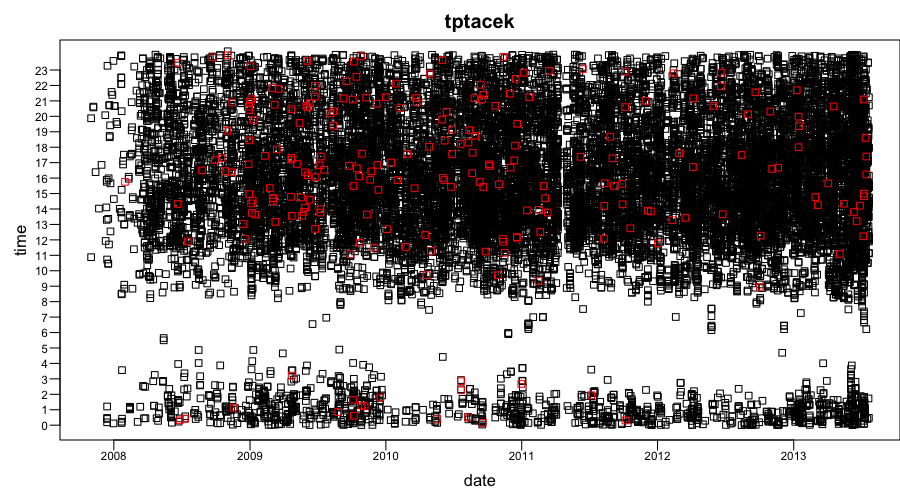
Notice the gap somewhere between 2:00 and 10:00. Presumably this is night time in this particular user's timezone. Likely this user is located in the PST timezone, which is 3 or 4 hours behind EST depending on daylight saving periods.
Below find other top 5 users' charts. One thing that struck me about those charts is the lack of apparent sleep patterns in some of them. Other than that I will leave the reader to make their own conclusions.

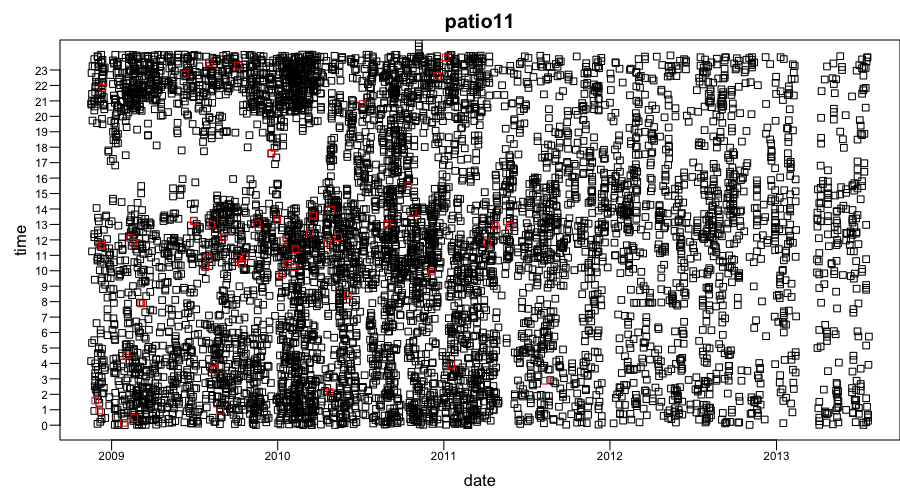
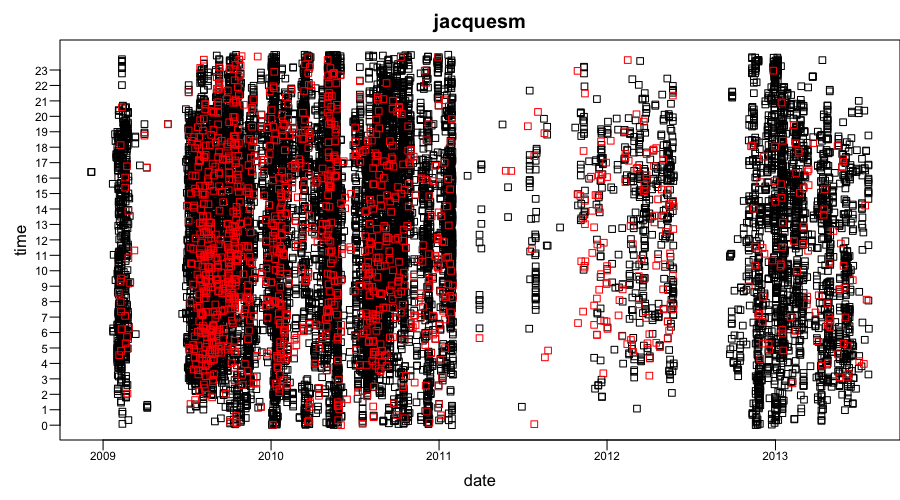
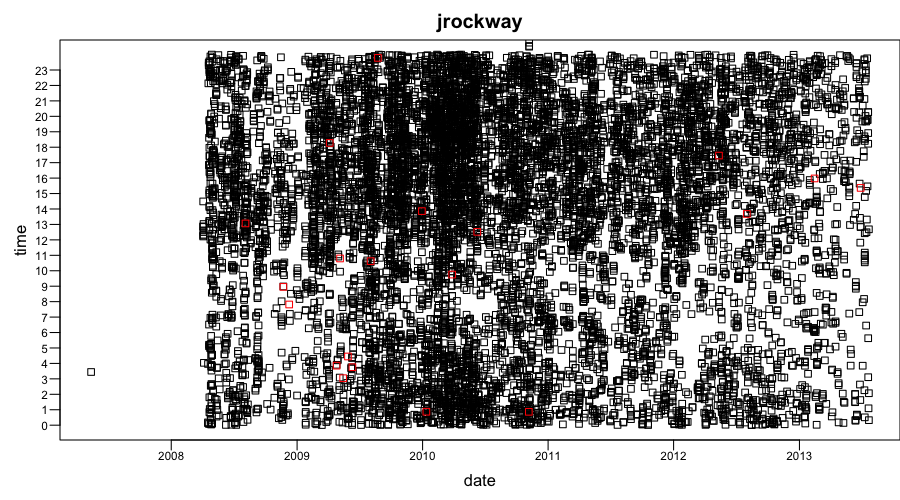
Using xts to aggregate and filter time series
xts is a handy library for working with time series data in R. Before you start using it, however, you have to install it using the commands below:
install.packages("xts") require(xts)
In order to harness xts functionality we need to create an xts object. The first thing we do below is create an xts object with only a date index and then add a column called count which is equal to 1 for all dates (this will help us with aggregation).
Note that the rest of this text only deals with HN posts. The same commands should work for comments as well though.
all_posts_xts = xts(order.by = all_posts$created_at) all_posts_xts = merge(all_posts_xts, count = 1) head(all_posts_xts)
## count ## 2006-10-09 14:21:51 1 ## 2006-10-09 14:30:28 1 ## 2006-10-09 14:40:33 1 ## 2006-10-09 14:47:42 1 ## 2006-10-09 14:51:04 1 ## 2006-10-09 14:56:40 1
Once we have an xts object we can use various aggregation and filtering functions. For example, let's aggregate the dates by month and plot the resulting object.
monthly_xts = apply.monthly(all_posts_xts, sum) # Remove the last month since it does not contain full data monthly_xts = monthly_xts[!time(monthly_xts) %in% time(last(monthly_xts))] par(mar = c(3.5, 4, 2, 0), las = 1, cex.axis = 0.7) plot(monthly_xts, ylim = c(0, 25000), xlab = "month", ylab = "number of posts", main = "Monthly numbers of posts", mgp = c(2.2, 1, 0), yaxt = "n", major.ticks = "years") par(mgp = c(3, 0.6, 0)) axis(2, at = 0:5 * 5000, cex.axis = 0.7, labels = 0:5 * 5000)
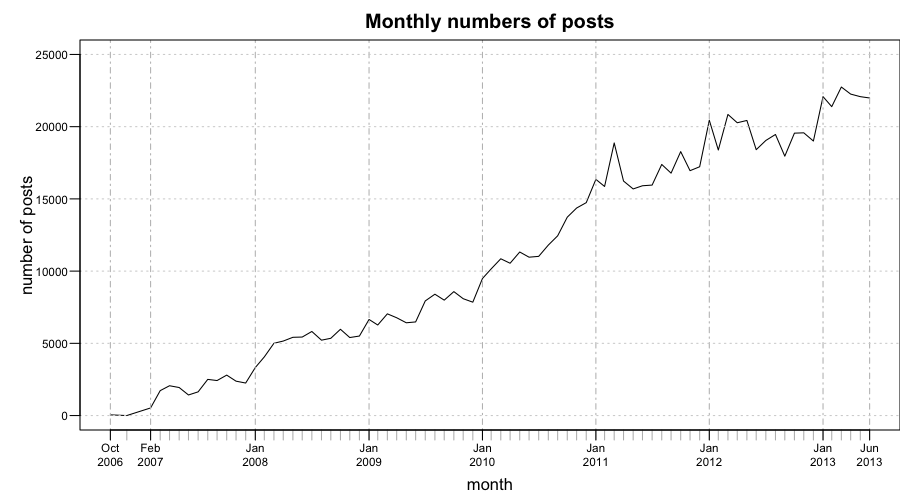
Let's aggregate post counts by day now
daily_xts = apply.daily(all_posts_xts, sum) # Remove the last day daily_xts = daily_xts[!time(daily_xts) %in% time(last(daily_xts))] par(mar = c(3.5, 4, 2, 0), las = 1, cex.axis = 0.7) plot(daily_xts, ylim = c(0, 1100), xlab = "day", ylab = "number of posts", main = "Daily numbers of posts", mgp = c(2.2, 1, 0), yaxt = "n", major.ticks = "years") par(mgp = c(1, 0.8, 0)) axis(2, at = 0:11 * 100, cex.axis = 0.7, labels = 0:11 * 100)
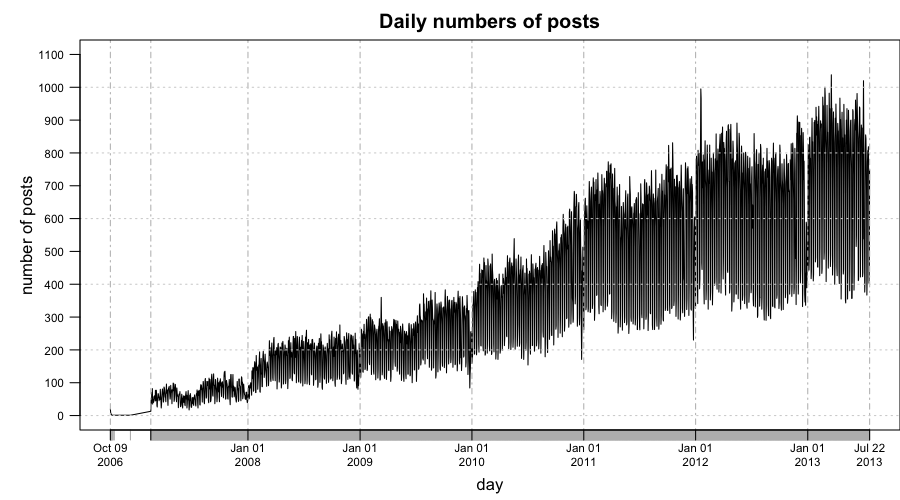
In the chart above it seems as though the number of posts varies a lot day to day. It's hard to see what's really happening here because a lot of the data points might be covered by lines connecting them. Let's try and draw the same plot, except for each data point we draw a little circle and no lines to connect them.
par(mar = c(3.5, 4, 2, 0), las = 1, cex.axis = 0.7) plot(daily_xts, ylim = c(0, 1100), xlab = "day", ylab = "number of posts", main = "Daily numbers of posts", mgp = c(2.2, 1, 0), yaxt = "n", major.ticks = "years", type = "p") par(mgp = c(1, 0.8, 0)) axis(2, at = 0:11 * 100, cex.axis = 0.7, labels = 0:11 * 100)
.png)
There are two lines or two clusters of data points. Presumably the upper one contains weekday data points and the one below contains weekends. To make sure it's true we will color weekends in red.
par(mar = c(3.5, 4, 2, 0), las = 1, cex.axis = 0.7) plot(daily_xts[.indexwday(daily_xts) %in% 1:5], ylim = c(0, 1100), xlab = "day", ylab = "number of posts", main = "Daily numbers of posts (weekends in red)", mgp = c(2.2, 1, 0), yaxt = "n", major.ticks = "years", type = "p") points(daily_xts[.indexwday(daily_xts) %in% c(0, 6)], type = "p", col = "red") par(mgp = c(1, 0.8, 0)) axis(2, at = 0:11 * 100, cex.axis = 0.7, labels = 0:11 * 100)
.png)
Outlier detection
In the previous chart we can observe that weekdays have quite some outliers. Weekends seem to have only a few outliers on the days that fall just before the new year. The weekday outliers are presumably holidays. Assuming that the majority of HN readers are from the US those should be US holidays.
For the sake of simplicity let's only look at the dates starting from the 1st of January 2012 and ending on the 22nd July 2013 (the last full day on the dataset).
weekdays_xts = daily_xts[.indexwday(daily_xts) %in% 1:5] weekdays_xts = weekdays_xts["2012-01-01::2013-07-22"] par(mar = c(3.5, 4, 2, 0), las = 1, cex.axis = 0.7) head(weekdays_xts)
## count ## 2012-01-02 23:59:22 571 ## 2012-01-03 23:59:15 768 ## 2012-01-04 23:57:52 790 ## 2012-01-05 23:58:12 767 ## 2012-01-06 23:55:36 684 ## 2012-01-09 23:59:14 808
plot(weekdays_xts, ylim = c(200, 1100), xlab = "day", ylab = "number of posts", main = "Daily numbers of posts on weekdays", mgp = c(2.2, 1, 0), yaxt = "n", major.ticks = "months") par(mgp = c(1, 0.8, 0)) axis(2, at = 2:11 * 100, cex.axis = 0.7, labels = 2:11 * 100)
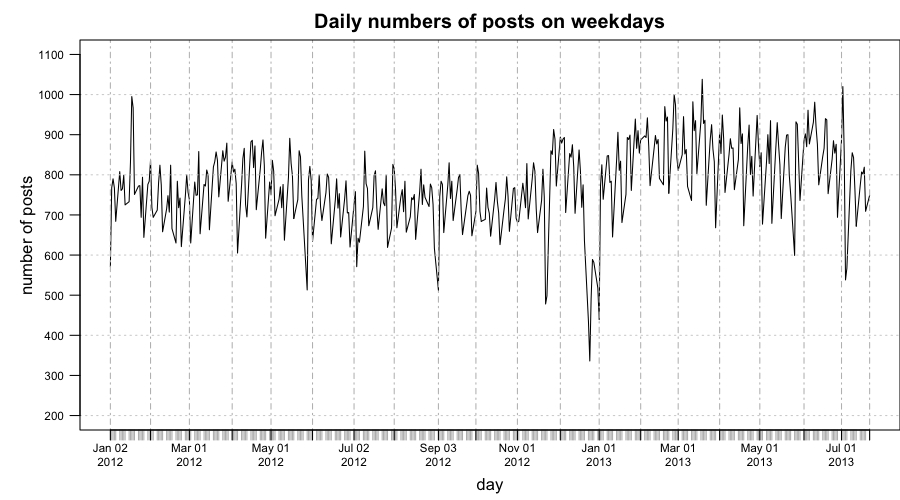
To avoid/minimize the effects of trend and seasonality we're going to smooth the curve using lowess smoother and then find outliers on the residuals we'll get after subtracting every datapoint from its smoothed value.
datapoints = coredata(weekdays_xts)[, 1] smoothed_datapoints = lowess(datapoints, f = 1/10) index = index(weekdays_xts) par(mar = c(3.5, 4, 2, 0), las = 1, cex.axis = 0.7) plot(weekdays_xts, ylim = c(200, 1100), xlab = "day", ylab = "number of posts", main = "Daily numbers of posts on weekdays", mgp = c(2.2, 1, 0), yaxt = "n", major.ticks = "months") lines(index, smoothed_datapoints$y, col = "red") axis(2, at = 2:11 * 100, cex.axis = 0.7, labels = 2:11 * 100)
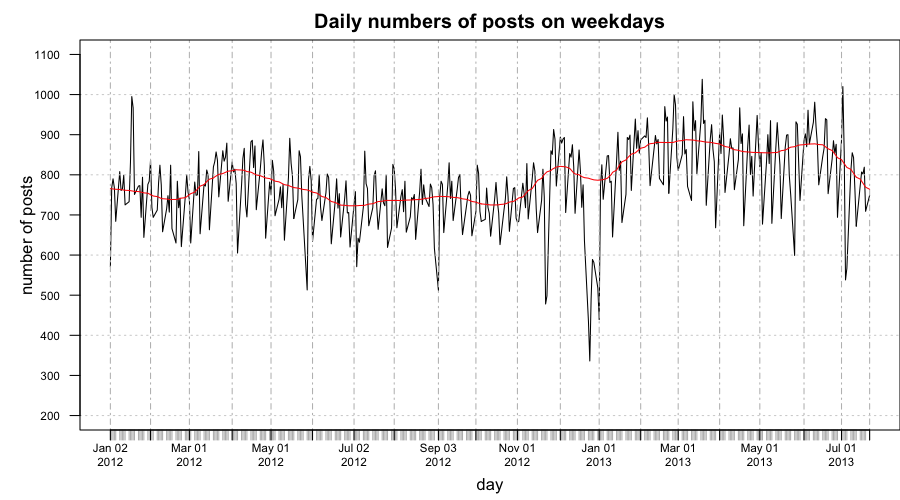
Let's see how the detrended graph looks like and mark the outliers with red circles.
weekdays_residuals = datapoints - smoothed_datapoints$y weekdays_residuals_xts = xts(weekdays_residuals, order.by = index(weekdays_xts)) par(mar = c(3.5, 3, 2, 0), las = 1, cex.axis = 0.7) plot(weekdays_residuals_xts, ylim = c(-500, 300), xlab = "day", ylab = "residual", main = "Residuals + outliers marked", mgp = c(2.2, 1, 0), yaxt = "n", major.ticks = "months") outliers = boxplot.stats(weekdays_residuals)$out points(index[which(weekdays_residuals %in% outliers)], weekdays_residuals[which(weekdays_residuals %in% outliers)], col = "red") axis(2, at = -5:3 * 100, cex.axis = 0.7, labels = -5:3 * 100)
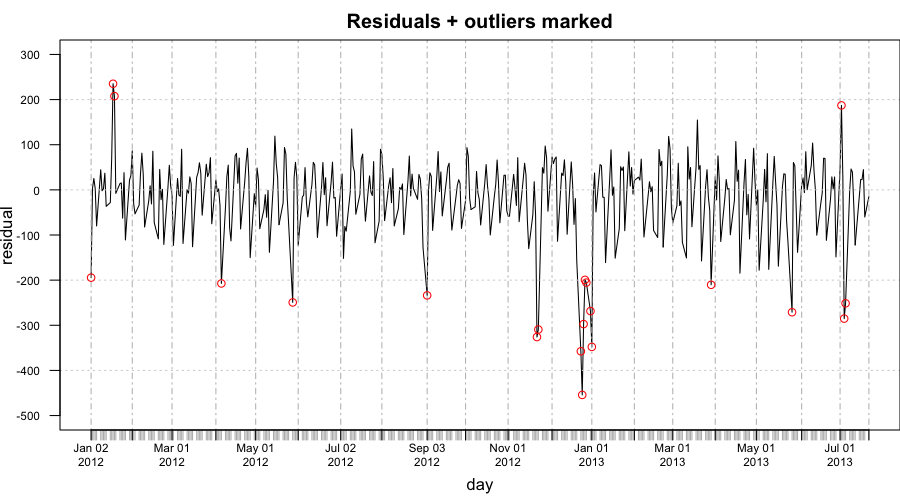
Next we output the outlier dates and draw the original weekday chart with outliers marked
# outliers that have unusually high daily number of posts outliers_high = outliers[outliers > 0] # outliers that have unusually low daily number of posts outliers_low = outliers[outliers < 0] index[which(weekdays_residuals %in% outliers_high)]
## [1] "2012-01-18 23:55:15 EST" "2012-01-19 23:57:52 EST" ## [3] "2013-07-02 23:59:23 EDT"
index[which(weekdays_residuals %in% outliers_low)]
## [1] "2012-01-02 23:59:22 EST" "2012-04-06 23:58:42 EDT" ## [3] "2012-05-28 23:57:56 EDT" "2012-09-03 23:59:24 EDT" ## [5] "2012-11-22 23:58:57 EST" "2012-11-23 23:55:45 EST" ## [7] "2012-12-24 23:56:51 EST" "2012-12-25 23:57:26 EST" ## [9] "2012-12-26 23:54:26 EST" "2012-12-27 23:55:58 EST" ## [11] "2012-12-28 23:57:53 EST" "2012-12-31 23:53:29 EST" ## [13] "2013-01-01 23:55:03 EST" "2013-03-29 23:57:17 EDT" ## [15] "2013-05-27 23:52:01 EDT" "2013-07-04 23:52:44 EDT" ## [17] "2013-07-05 23:58:14 EDT"
par(mar = c(3.5, 3, 2, 0), las = 1, cex.axis = 0.7) plot(weekdays_xts, ylim = c(200, 1100), xlab = "day", ylab = "number of posts", main = "Daily numbers of posts on weekdays", mgp = c(2.2, 1, 0), yaxt = "n", major.ticks = "months") points(index[which(weekdays_residuals %in% outliers)], datapoints[which(weekdays_residuals %in% outliers)], col = "red") axis(2, at = 2:11 * 100, cex.axis = 0.7, labels = 2:11 * 100)
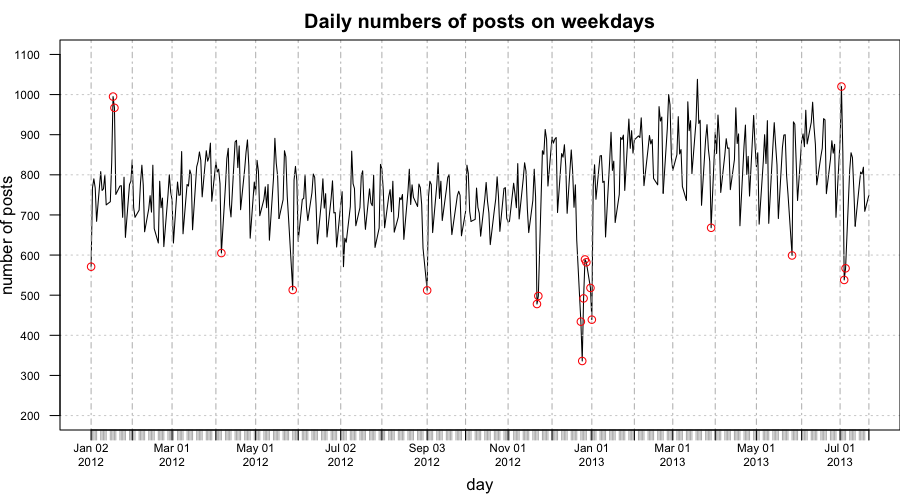
Attempting to explain the outliers
Most outliers are related to low numbers of posts due to holidays some of which are common to both US and Europe (e.g. Christmas), others only present only in the US (e.g. Thanksgiving).
Christmas period is the largest outlier, this is probably because it's a holiday that's common across so many different countries. However, Thanksgiving is quite a large outlier too, that is probably because the majority of HN users are based in the US.
It's interesting that the 3 high outliers are not holidays but are very close to holidays. The 18th and the 17th of Jan 2012 are high outliers that come after the 16th of Jan which is Birthday of Martin Luther King, Jr. and the 2nd of July is very close to the 4th of July (Independence Day). Either there were more interesting news items during those days or people were reading and posting more stories for some other reason.
| Unusually low values | |
| 2012-01-02 | New Year's Day |
| 2012-04-06 | Good Friday |
| 2012-05-28 | Memorial Day |
| 2012-09-03 | Labor Day |
| 2012-11-22 | Thanksgiving Day |
| 2012-11-23 | Day after Thanksgiving |
| 2012-12-24 | Christmas Season |
| 2012-12-25 | Christmas Day |
| 2012-12-26 | Christmas Season |
| 2012-12-27 | Christmas Season |
| 2012-12-28 | Christmas Season |
| 2012-12-31 | Christmas Season |
| 2013-01-01 | New Year's Day |
| 2013-03-29 | Good Friday |
| 2013-05-27 | Memorial Day |
| 2013-07-04 | Independence Day |
| 2013-07-05 | Day after Independence Day |
| Unusually high values | |
| 2012-01-18 | Soon after Birthday of Martin Luther King, Jr. |
| 2012-01-19 | Soon after Birthday of Martin Luther King, Jr. |
| 2013-07-02 | July 4th approaching |
Final word
I hope the examples will be useful for someone as a learning material or someone will enjoy seeing the HN stats charts. Please let me know if you do any interesting experiments with the HN metadata posted on Github. To get in touch send me an email or follow me on twitter.
Thanks to Adomas Paltanavičius for proofreading this text.







_thumb.png)
_thumb.png)



